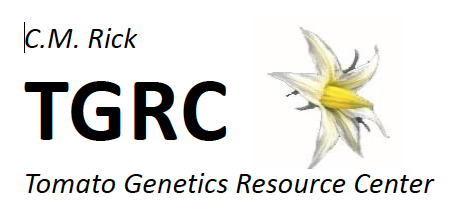
The TGRC has developed a set of introgression lines (ILs) representing the genome of S. sitiens (accessions LA4331 and LA1974) in the genetic background of S. lycopersicum cv. NC 84173 (LA4354), a fresh market breeding line (Gardner 1992). The IL library consists of ca. 56 overlapping introgressions that together represent about 93% of the S. sitiens genome: 65% in homozygous and 28% in heterozygous (segregating) ILs. Each line contains a single alien chromosome segment, delineated by SolCAP SNP markers, as shown in the figure below from Chetelat et al. (2019). Additional recombinant subILs from large introgressions have also been isolated.

Red segments in the map above are derived from S. sitiens LA1974, blue from LA4331; green segments are from S. lycopersicoides LA1964. Solid lines represent homozygous regions and dashed lines heterozygous regions. (This map is available for download below.)
Many of the lines have reduced fertility, particularly as homozygotes, and will generally set fruit better under greenhouse than under field conditions. Manual self pollination may be needed, in some lines, to produce seed. Progeny of heterozygotes typically yield a deficiency of plants homozygous for the introgressed segments – and often fewer than expected heterozygotes as well – so population sizes should take this into account.
To view of a list of the currently available lines, search Database Queries/Accession Search, click on Advanced Search, then choose Status = "Active" and Accession Category = "Introgression line (S. sitiens)".
More information on the development of this prebred germplasm resource can be found here.

References
Chetelat, R. T., X. Qin, M. Tan, D. Burkart-Waco, Y. Moritama, X. Huo, T. Wills and R. Pertuzé (2019) Introgression lines of Solanum sitiens, a wild nightshade of the Atacama Desert, in the genome of cultivated tomato. The Plant Journal 100: 836-850.
Gardner, R. G. (1992) 'Mountain Spring' tomato; NC 8276 and NC 84173 tomato breeding lines. J. Amer. Soc. Hort. Sci. 27: 1233-1234.
